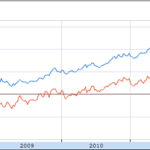Evidently, there’s a race to the bottom in trading commissions seeing as how there are new discount brokers popping up with various free/low-fee commissions and now, multiple large names are offering trading on ETFs they manage or have relationships with absolutely free. Given that ETFs are Better Than Mutual Funds in virtually all aspects and most retail investors would actually be much better off investing in ETFs rather than individual stock-picking, it’s certainly welcome news to see absolute commission-free trading opportunities for ETF investors growing. Here are a few options at your disposal now – and the list is growing!
Vanguard
Vanguard is a leader in terms of low cost funds and indexing. They just announced their program this week. Now, not only can you enjoy free ETF trading for their 46 offerings, but they often have a lower expense ratio than their peers for added benefit. As such, Vanguard appears to win in terms of both cost and variety of offerings. They tout the success of the $13 billion Vanguard Total Stock Market ETF (VTI), the $20 billion Vanguard Emerging Markets ETF (VWO), and the $7 billion Vanguard Total Bond Market ETF (BND) as compelling offerings. Aside from the free ETF trading, Vanguard has a rather intriguing pricing schedule for trading stocks and ETFs outside their offerings elsewhere in their account. It’s $7 per trade for the 1st 25 trades in a given year, but after that the commission rises to $20 (for investors with less than $50,000 in their accounts). While many brokerages offer discounts in volume, Vanguard takes the exact opposite approach and actually penalizes heavy trading. This meshes with their belief that over the long run, investors lose when they trade heavily.
Schwab
Schwab carries 8 ETFs in main categories such as US diversified and emerging markets. While the ETFs trade free, it’s $8.95 for third party trades. They seem to have strategically priced their expense ratios to be exactly equivalent to or just .01% lower than Vanguard’s equivalent offerings. For instance, for the Schwab U.S. Broad Market ETF (SCHB), the expense ratio is 0.08% vs. Vanguard’s (VTI) ratio of 0.09%. While it’s a nice thought, it’s probably not worthwhile switching over the marginal improvement if Vanguard was already your first choice.
Fidelity
Fidelity has a program allowing for trading in their 25 associated ETFs with a moderately wide swath of offerings. Their ETFs include the standard large and small cap US and emerging markets, but also includes TIPs, muni ETFs and several others. Outside their free offerings, trades are $7.95.
Given the pricing and offerings, Vanguard appears to offer the best value, but as more companies are pressured to move in the same direction and as more new ETFs are launched, it surely bodes well for retail investors.
Disclosure: No position in any ETFs referenced in this article.










{ 0 comments… add one now }
{ 1 trackback }